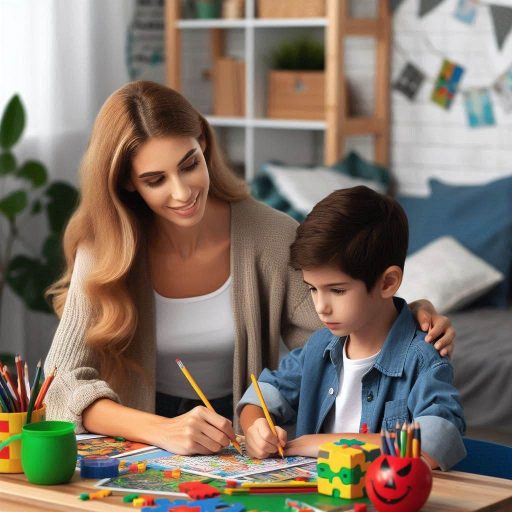Introduction
Educational therapy is a specialized form of intervention for students facing learning disabilities or challenges.
It plays a crucial role in facilitating their academic and personal growth.
Measuring Progress in Educational Therapy
Tracking progress in educational therapy is essential to gauge the effectiveness of interventions and adjust strategies accordingly.
- Evaluation Tools: Utilize standardized assessments to measure academic skills improvement and monitor cognitive development over time.
- Observational Data: Collect observational data to track behavioral changes, social interactions, attention span, and emotional regulation in different settings.
- Goal Setting: Establish clear and measurable goals with students and their families to track progress and celebrate achievements along the way.
- Progress Reports: Provide regular progress reports to showcase advancements in specific areas and identify areas that still need improvement.
- Feedback Mechanism: Encourage open communication with parents, teachers, and other stakeholders to gather feedback on the student’s progress and make necessary adjustments.
- Data Analysis: Analyze data collected from assessments, observations, and feedback to make informed decisions about the effectiveness of educational therapy interventions.
- Continuous Learning: Continuously update professional knowledge to stay informed about the latest research and best practices in educational therapy assessment and measurement.
By employing a combination of evaluation tools, observational data, goal setting, progress reports, feedback mechanisms, data analysis, and continuous learning, educators can effectively measure progress in educational therapy and ensure the best possible outcomes for students with learning disabilities.
Setting clear goals
Setting clear goals is essential for effective educational therapy.
Specific, measurable, achievable, relevant, and time-bound (SMART) goals provide direction and focus.
By defining these goals, both the therapist and the student understand the desired outcomes.
This clarity fosters a sense of purpose and motivation, making each session more productive.
Specific goals
Specific goals identify the exact skills or areas that need improvement.
Instead of vague objectives like “improve reading,” a specific goal might state, “increase reading comprehension by two grade levels.”
This precision ensures that the therapy targets the student’s unique needs.
Measurable goals
Measurable goals are critical for tracking progress.
When goals are quantifiable, it becomes easier to assess whether the student is improving.
For instance, measuring progress might involve tracking test scores or monitoring the number of errors made in reading exercises.
These metrics provide tangible evidence of success or areas needing further attention.
Achievable goals
Achievable goals are realistic and attainable within the student’s current abilities and resources.
Setting overly ambitious goals can lead to frustration and decreased motivation.
Instead, achievable goals ensure steady progress, building the student’s confidence.
Relevant goals
Relevant goals align with the student’s overall educational needs.
They address the most critical areas that impact the student’s learning and development.
Transform Your Career Today
Unlock a personalized career strategy that drives real results. Get tailored advice and a roadmap designed just for you.
Start NowBy focusing on what truly matters, therapy sessions become more effective and efficient.
Time-bound goals
Time-bound goals create a sense of urgency and help in planning the therapy sessions.
With a clear timeline, both the therapist and the student can stay on track, ensuring that progress is made consistently.
If goals are not met within the set timeframe, it signals the need to adjust strategies.
In short, setting clear SMART goals in educational therapy is vital.
It guides the therapy process, helps track progress, and ensures that strategies are adapted as needed.
Read: Case Management in Educational Therapy: Best Practices
Regular assessments
Significance of conducting regular assessments to monitor the student’s progress
Regular assessments are crucial in monitoring student progress in educational therapy.
These assessments provide valuable insights into the effectiveness of the therapy interventions.
They help therapists track changes in student behavior, academic performance, and emotional well-being.
Conducting regular assessments allows for the identification of any underlying issues or challenges that may be hindering progress.
It also enables therapists to make adjustments to the treatment plan as needed to better support the student’s needs.
Types of assessments
- Standardized tests: These assessments provide a standardized measure of a student’s academic abilities compared to their peers.
- Informal observations: Therapists can gather valuable information through informal observations of a student’s behavior and interactions in the learning environment.
- Progress reports: These reports track the student’s progress over time, highlighting areas of improvement and areas that may require further attention.
- Behavioral assessments: These assessments focus on observing and analyzing a student’s behavior in various settings to identify patterns and triggers.
Read: Educational Therapy for Emotional and Behavioral Issues
Tracking behavior changes
The need to track not only academic progress but also changes in behavior, confidence, and motivation
Tracking behavior changes is a crucial aspect of measuring progress in educational therapy.
It is essential to recognize that improvement in academic performance is not the only goal of therapy.
Changes in behavior, confidence, and motivation are equally important indicators of success.
When tracking behavior changes, therapists should pay attention to how students interact with their peers and teachers.
Increased social engagement, improved communication skills, and a more positive attitude towards learning are all signs of progress.
These behavioral improvements can have a significant impact on academic performance.
Showcase Your Business Today
Reach thousands of readers actively exploring professional services. Publish your business profile and grow your audience now.
Publish NowAnother key indicator to consider is self-confidence.
Educational therapy aims to build students’ self-esteem and belief in their abilities.
As students become more confident in their skills and knowledge, they are likely to take on challenges with a positive mindset and persevere through difficulties.
Motivation is also a critical factor in measuring progress.
Therapists should observe whether students show a newfound enthusiasm for learning, take initiative in their studies, and set goals for themselves.
Increased motivation often leads to better academic outcomes and a more positive attitude towards education.
Examples of behavioral indicators that can be used to measure the effectiveness of educational therapy
To measure the effectiveness of educational therapy, therapists can use various behavioral indicators.
Some examples include improved attendance and punctuality, better time management skills, increased participation in class discussions, and a more positive attitude towards schoolwork.
Additionally, therapists can look for changes in students’ study habits, such as increased organization and preparedness for assignments and exams.
Students who demonstrate better focus, persistence, and resilience in the face of challenges are likely benefiting from the therapy.
Overall, tracking behavior changes in students is essential for evaluating the impact of educational therapy.
By monitoring improvements in behavior, confidence, and motivation, therapists can gain valuable insights into the effectiveness of their interventions and make necessary adjustments to support students’ progress.
Read: Collaborating with Teachers and Educational Therapists

Communication with parents/guardians
Importance of keeping parents/guardians informed about the student’s progress
Maintaining open communication with parents or guardians is crucial in educational therapy.
Keeping them informed about the student’s progress helps build trust and ensures everyone is aligned in supporting the student’s growth.
Regular updates allow parents to understand how their child is responding to the therapy.
They can see the specific areas of improvement and challenges.
This transparency fosters a sense of involvement and empowers parents to reinforce the strategies at home.
Informed parents are better equipped to provide emotional and academic support to their children.
They can celebrate successes, address concerns, and stay motivated to continue the therapeutic process.
When parents feel connected to their child’s progress, it strengthens the student’s overall support system.
How regular communication can help in maintaining a collaborative approach between the therapist, parents, and other educators
Regular communication also ensures that the therapist, parents, and other educators maintain a collaborative approach.
By sharing insights and observations, everyone involved can contribute to the student’s success.
This collaboration is key to addressing the student’s unique needs effectively.
Consistent updates prevent misunderstandings and help manage expectations.
When everyone is on the same page, it reduces the likelihood of frustration or confusion.
This clarity leads to a more productive therapeutic environment.
Moreover, parents can share valuable information about their child’s behavior or challenges outside of therapy sessions.
This feedback allows the therapist to tailor the sessions more effectively.
It also ensures that the strategies used in therapy are reinforced at home and school.
In summary, communication with parents or guardians is essential in educational therapy.
It ensures a united effort to support the student’s progress.
By keeping parents informed and involved, therapists can create a more effective and supportive learning environment for the student.
Read: Educational Therapy and Its Role in IEP Meetings
Utilizing data and documentation
Importance of maintaining detailed records and documentation of the student’s progress
Keeping detailed records and documentation of a student’s progress in educational therapy is crucial for various reasons:
- Documentation provides a clear picture of the student’s initial performance level.
- It helps track the effectiveness of different interventions and strategies over time.
- Having detailed records allows for better communication among therapists, educators, and parents.
- It serves as a reference point to monitor long-term progress and set realistic goals.
- Documentation protects both the student and the therapist by providing evidence of the work done.
Data analysis in educational therapy
Data analysis plays a vital role in identifying patterns, trends, and areas of improvement in educational therapy sessions:
- By analyzing data, therapists can assess the effectiveness of specific interventions and adjust their approach accordingly.
- Identifying patterns in student performance can help in understanding underlying issues that may be hindering progress.
- Tracking trends over time allows therapists to measure the impact of their strategies and make informed decisions.
- Data analysis helps in identifying areas where additional support or resources may be needed to enhance the student’s progress.
- It also enables therapists to demonstrate the impact of their work through quantifiable results and progress reports.
Overall, utilizing data and maintaining detailed documentation are essential components of measuring progress in educational therapy.
They provide valuable insights, guide decision-making, and ensure effective communication among all stakeholders involved in the student’s education and development.
Celebrating small victories
Encouraging therapists to celebrate small victories and milestones achieved by the student
Therapists should celebrate small victories and milestones achieved by students.
Recognizing progress, no matter how minor, boosts confidence and reinforces the effort students put into their work.
Showcase Your Business Today
Reach thousands of readers actively exploring professional services. Publish your business profile and grow your audience now.
Publish NowCelebrations can be simple but meaningful, such as verbal praise, stickers, or a small reward.
These moments of recognition help students see the value in their efforts, motivating them to continue working towards their goals.
Encouragement helps students develop a growth mindset.
By celebrating small victories, therapists show students that progress is possible and that every step forward is important.
This mindset shift can change how students approach learning, making them more resilient and willing to tackle difficult tasks.
Over time, these small victories accumulate, leading to significant progress and a stronger sense of self-efficacy.
Positive impact of positive reinforcement
Positive reinforcement and encouragement significantly impact a student’s motivation and progress.
When students receive positive feedback, they feel more confident in their abilities and are more likely to persevere through challenges.
Reinforcement can be as simple as a smile or a kind word, but its effects are profound.
It reinforces the connection between effort and achievement, encouraging students to keep striving for improvement.
Therapists should also involve students in the celebration process.
Allowing students to reflect on their achievements helps them internalize their progress and recognize their strengths.
This practice not only boosts self-esteem but also fosters a sense of ownership over their learning journey.
By making celebration a regular part of therapy, therapists create a positive and supportive environment where students feel valued and motivated to succeed.
Seeking feedback from students
The value of seeking feedback from students about their experiences in educational therapy sessions
Seeking feedback from students in educational therapy sessions is invaluable.
It provides insight into their experiences and helps tailor approaches to meet individual needs.
Students can offer a unique perspective on what methods resonate with them, highlighting which strategies promote learning and which do not.
Actively encouraging students to share their thoughts creates a collaborative environment.
It empowers them to take ownership of their learning process, enhancing engagement and motivation.
When students feel their opinions matter, they are more likely to participate actively in therapy sessions.
How student input can help in evaluating the effectiveness of strategies used and making necessary adjustments
Student input is crucial for evaluating the effectiveness of the strategies used in educational therapy.
Regular feedback helps identify which techniques are successful and which may require modification.
This ongoing evaluation ensures that the therapy remains dynamic and responsive to the student’s evolving needs.
By listening to students, therapists can make informed adjustments to their methods.
These changes can improve the overall efficacy of the therapy, leading to better educational outcomes.
When students see that their feedback leads to tangible improvements, their trust in the process strengthens.
Incorporating student feedback into therapy sessions also fosters a growth mindset.
It encourages students to reflect on their learning journey, helping them understand their progress and areas for improvement.
This reflection can boost their confidence and reinforce a positive attitude toward learning.
Ultimately, seeking student feedback is a powerful tool in educational therapy.
It allows for a personalized approach, ensuring that each student receives the support they need to succeed.
By valuing and incorporating their input, therapists can create a more effective and engaging learning experience.
Reflecting and adjusting strategies
Reflecting on the progress made during educational therapy sessions is crucial for both therapists and students.
It allows therapists to evaluate the effectiveness of their current strategies, identify areas for improvement, and make necessary adjustments to ensure the best outcomes for their students.
Here are some key points to consider when reflecting and adjusting strategies in educational therapy:
Establish a culture of continuous reflection
Emphasize the importance of ongoing reflection as a regular practice in educational therapy.
Encourage therapists to set aside time during or after each session to reflect on what worked well and what could be improved.
Utilize feedback from students and parents
Feedback from students and parents is invaluable in understanding the impact of educational therapy sessions.
Encourage therapists to actively seek feedback and suggestions for improvement from both students and their parents.
Use assessments to track progress
Regular assessments are essential for tracking student progress and determining the effectiveness of educational therapy interventions.
Showcase Your Business Today
Reach thousands of readers actively exploring professional services. Publish your business profile and grow your audience now.
Publish NowEncourage therapists to use a variety of assessment tools to gather data and measure student growth over time.
Observe student behavior and engagement
Observing students during therapy sessions can provide valuable insights into their behaviors, attitudes, and level of engagement.
Encourage therapists to closely observe students’ reactions to different interventions and adjust their strategies accordingly.
Collaborate with other professionals
Collaboration with other education and mental health professionals can provide fresh perspectives and new ideas for improving educational therapy sessions.
Encourage therapists to seek feedback and guidance from colleagues in related fields.
Stay flexible and open-minded
Encourage therapists to remain flexible and open-minded when reflecting on their strategies.
Being willing to adapt and try new approaches based on feedback and observations is key to achieving positive outcomes in educational therapy.
In a nutshell, reflecting and adjusting strategies in educational therapy is essential for optimizing student outcomes and ensuring continuous improvement in therapy sessions.
By prioritizing ongoing reflection, feedback, assessments, and collaboration, therapists can provide students with the tailored support they need to thrive academically and socially.
Conclusion
Educational therapists play a crucial role in helping students overcome learning challenges and achieve academic success.
Tracking progress is essential in educational therapy to ensure that interventions are effective and goals are being met.
One way to measure progress is through regular assessments that target specific skills or areas of concern.
Setting clear and measurable goals with students and their parents can provide a roadmap for success.
Using data to inform decisions and make adjustments to therapy approaches is key to driving student progress.
Effective communication with teachers and other professionals involved in the student’s education is also important for tracking progress.
Keeping detailed records and documentation of interventions and outcomes can help therapists evaluate effectiveness over time.
Celebrating small victories and milestones along the way can boost student motivation and overall success in therapy.
Measuring progress in educational therapy involves tracking, setting goals, and making adjustments for the best outcomes.
Therapists should prioritize these key points to ensure that their students are making meaningful progress and achieving their full potential.
[E-Books for Sale]
The Big Book of 500 High-Paying Jobs in America: Unlock Your Earning Potential
$19.99 • 500 High-Paying Jobs • 330 pages
Explore 500 high-paying jobs in America and learn how to boost your career, earn more, and achieve success!
See All 500 High-Paying Jobs of this E-Book
1001 Professions Without a Degree: High-Paying American Jobs You Can Start Now
$19.99 • 1001 Professions Without a Degree • 174 pages
Discover 1001 high-paying jobs without a degree! Unlock career tips, skills, and success strategies for just $19.99!




